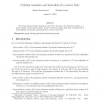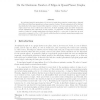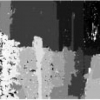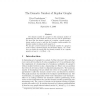524 search results - page 16 / 105 » On the Maximum Number of Cliques in a Graph |
CORR
2010
Springer
13 years 7 months ago
2010
Springer
We obtain improved upper bounds and new lower bounds on the chromatic number as a linear function of the clique number, for the intersection graphs (and their complements) of fini...
JCT
2007
13 years 7 months ago
2007
A topological graph is quasi-planar, if it does not contain three pairwise crossing edges. Agarwal et al. [2] proved that these graphs have a linear number of edges. We give a sim...
CVPR
1998
IEEE
14 years 9 months ago
1998
IEEE
Markov Random Fields (MRF's) can be used for a wide variety of vision problems. In this paper we focus on MRF's with two-valued clique potentials, which form a generaliz...
CORR
2004
Springer
13 years 7 months ago
2004
Springer
A Meyniel graph is a graph in which every odd cycle of length at least five has two chords. We present a linear-time algorithm that colors optimally the vertices of a Meyniel grap...
ARSCOM
2004
13 years 7 months ago
2004
The domatic number of a graph G is the maximum number of dominating sets into which the vertex set of G can be partitioned. We show that the domatic number of a random r-regular g...




